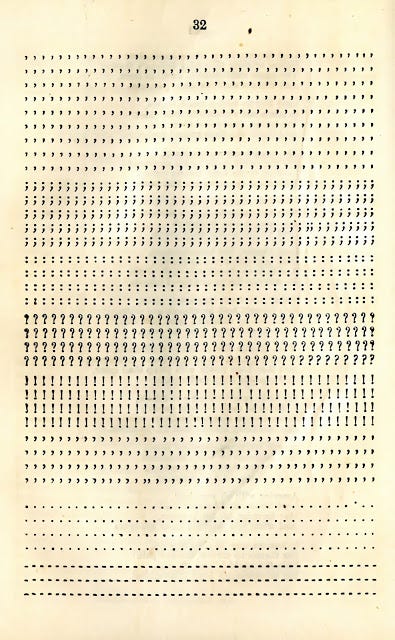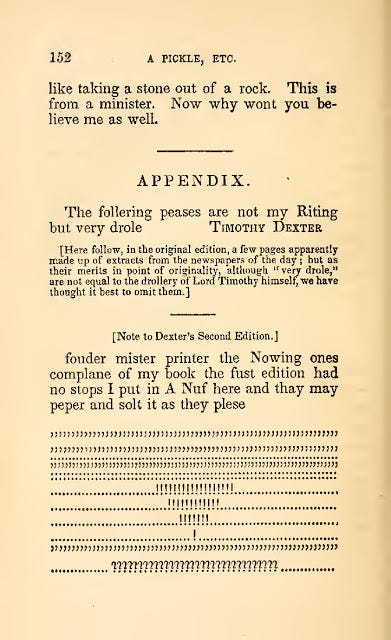Timothy Dexter — Page 32 (AKA Punctuation Page) from “A Pickle for the Knowing Ones”

Being clueless can start a legend. Timothy Dexter (1747–1806) was an interesting person to say the least. He was happy-go-lucky businessman from late 18th century. He had little to no education and absolutely supernatural sense of business opportinity. The man just knew what he had to do even though people were laughing at him almost all the time. Which came in handy in the recently declared independent Land of Opportunity AKA USA.
One of his most epic business exploits was when he shipped coal to Newcastle. People thought it was a stupid idea, a surefire bankrupcy. But it happened during a miner’s strike so it was sold very well. Later he exported stray cats to Caribbean islands to same reaction and it turned out to be a fine solution to a rat infestation problem. And then he shipped Bibles to West India just when the missionaries were in need of them…
He was also a notorious joker. He once told everybody that his had wife died and that the woman frequently seen walking in the house was just a ghost.
But his most infamous deed was writing a book. It was first released in 1802 and since then it was rereleased numerous times. It was terrible. Except for one thing.
***

This is a page 32 from the second edition of Timothy Dexter’s book “A Pickle for the Knowing Ones or Plain Truth in a Homespun Dress”. Its sole content are punctuation marks. A lot of punctuation marks: entire lines of comas, semicolons, colons, question marks, exclamation marks, more comas, dots and hyphens.
Punctuation is something the rest of “A Pickle for the Knowing Ones” was notoriously lacking. The first edition was just a wall of text broken into chunks seemingly at random with a liberal use of capitalization. Because one does not have time for such petty thing when he’s a got to tell his life story. Then, in the second edition Dexter added an extra page with punctuation marks as a response to a criticism. It was specifically for those who wanted to see some punctuation in the book.
The page was daring them to insert it back where it should have been — as the man said himself “peper and solt it as they plese”. Basically, a direct instruction to tear the page from the book, cut it into pieces and insert into the other pages.
This makes page 32 an early example of both conceptual writing and interactive fiction. Although mostly unintentional, since Dexter was just a serious man who wanted to tell a story of his life and opinions and stuff.
The page is layed out in a chromatic manner — one type of punctuation goes after another — paragraph after paragraph. It is very straightforward. Together paragraphs of punctuation marks develop massive, imposing visual rhythm — it is blatant and blunt and boisterous but also incredibly affecting. It succeeds in making an impression. Its deceptive straightforwardness is so enigmatic — it makes a fine fodder for an exquisite bout of creative overthinking. It just can’t be that simple, there must be something hidden behind these walls of punctuation marks even though it is just an offhand dig.
There are slight variations sprinkled here and there.
For example, sometimes marks are coupled together due to omitted space. There are two such instances — one with semicolons and the other with comas. In a way, it almost tells a story of noncomformity among the lines of punctuation.
And then there are double spaces that break the visual rhythm of the line — like in the exclamation mark paragraph. When you look through the page — line by line — this stumble is slighly disorienting.
Or you can find an exclamation mark sneaked into the question mark paragraph. It just happened to be there because why not — some excalamation marks like to hang out with the question marks — such is life.
And then there is a bullet point in the dots paragraph — proudly standing above the other marks. It is another story of noncomformity on this page — one nasty “take that” moment.
***

There is also very interesting version from Samuel L. Knapp 1858 biography of Timothy Dexter that included “A Pickle…” in its second part. In this version — it is substantially modified. The original page is condensed to a really thick block in the bottom of the page.
It also rearranges the positioning of the punctuation marks. Comas which were originally preceding dots are now situated after the dots and hyphens are replaced with dots. Instead of a strict succession of the symbols — there is a different layout — exclamation marks are inserted into the dots lines to form a descending triangle shape. Then goes a strikethrough plain of comas and another line of dots with an emanating mist of the question marks.
In a bizarre accident the overall visual shape of this variation is very reminiscent of an iconic photo from the Bikini Atoll Crossroads Weapon test. Which is weird.
On the next page we can another punctuation composition. Basically, it is an appendix to an appendix. It is inspired by the original and greatly expands it.
But instead of simply providing a full page of punctuation marks in concrete composition (AKA barely identified textual object) for the portentous feast of imagination, it attempts building some sort of a abstract piece with punctuation marks. And aptly fails to construct anything in particular. It is just another horde of punctuation marks that form some abstract angular shapes. If you look long and close enough it will definitely look like something apparently nondescript. There is definitely something that mind is just unable to identify the pattern.

The page greatly expands the variety of punctuation marks. Aside from traditional comas, dots, semicolons, colons, question marks, excalamation marks and hyphens — there are brackets round and square, horizontal curvy brackets, underscores, dashes, quotation marks. New signs are placed together and make great change of pace in the mundane composition.
These additions elevate the piece beyond concrete. They change the perspective into a very different plain — it is more of a performance score than simply a concrete punctuation composition.
New signs also add a slight physical element to the piece. The piece steps out beyond its boundaries. Quotation marks broken by underscores aptly evoke winking. Round and square brackets are visually similar to an opened mouth. Horizontal curvy bracket are like frowning brows. And then, once again, flats of dots and hyphens with a string of comas hanging like trophees. Unlike previous plains of colons and comas — these lines of dots and hyphen are very sound-alike, almost as if they were lines for humming.
Bottom of the page unleashes onslaught of pilcrows, daggers, double vertical lines and section signs. They are confined to a single line and greatly disrupts general pace of the composition. The rest of the symbols — disjointed crowd of question marks, colons, exclamation marks, comas, donts, and occassional quotation marks with hyphens are like cornered refugees.
Overall, this variation offers completely different experience and aptly shows the possibilities of punctuation-only writing.
***
Curiously, the online version of the page available on one of the Dexter’s fan-pages got very different composition. It follows closely Knapp’s 1858 version in the layout but also changes several crucial elements.
The biggest change is that it omits several punctuation marks — semicolons, colons and hyphens are missing. Instead, they are transformed into more comas and dots, probably due to lacking optical image recognition. There are comas, dots and more comas and more dots, exclamation marks and more dots and more comas and more dots, question marks and even more dots. The descending triangle is still there but it is more of a glimmer than a solid construction.
It is spacier, sparser, less dense version. Line spacing is much bigger and this disintegrates the image. In some way, it looks like a rows of an army (the one Joyce heard) in the field with different marks being different kind of troops.
The lines itself are extremely compressed. First four lines of comas and dots are divided five bits while the rest are left in a single piece. Last line is so condensed it ends up shorter than the rest.
Overall, it is much more abstract that 1858 version and because of that it is less effective — it just hangs there without having much to do.
***
Sometimes all it takes for a book to last is one stroke of brialliance that makes difference.
Page 32 is a crown jewel of otherwise unbearably horrendous mess that erupts void of awkwardness on those who tried to read it.
